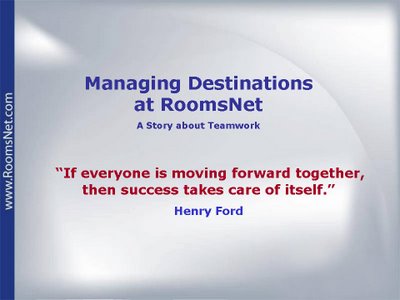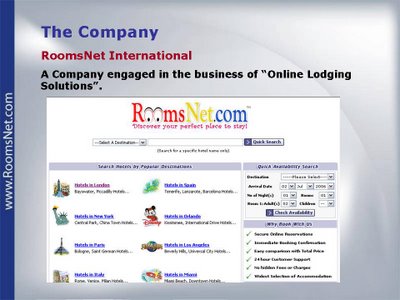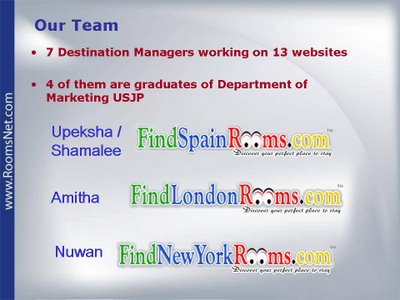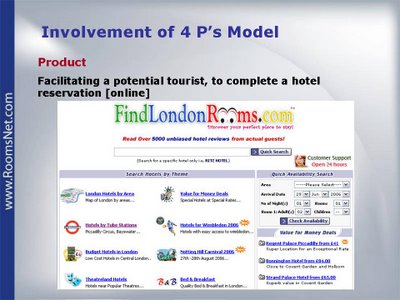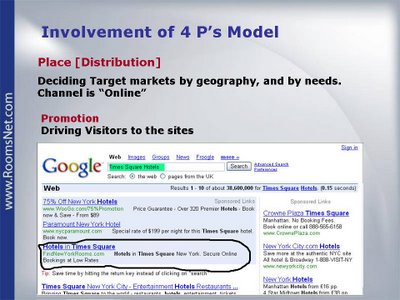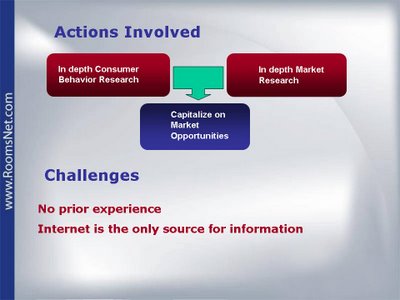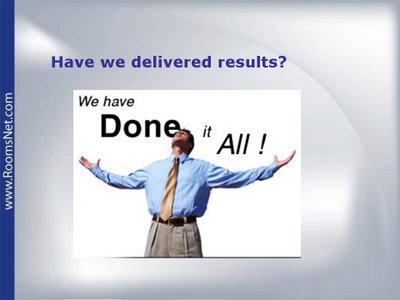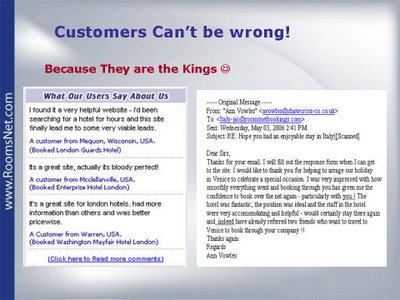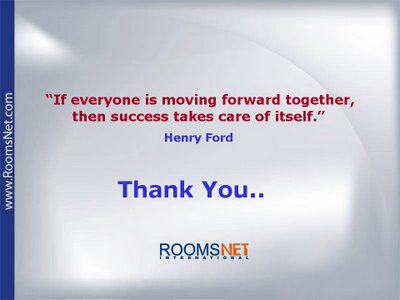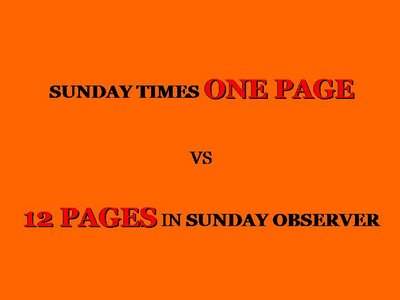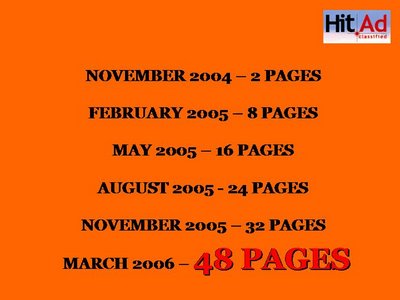Tuesday, October 10, 2006
Six Ways to Keep Your Web Pages Simple and Increase Sales
Here are six ways to keep your pages simple and increase conversions.
1. Stick to one topic per page
This may not be possible always. But if you can stick to just a single topic, product, or service per page, then you simplify the experience for your visitors.
They don't have to choose—they don't have to decide where to focus their attention. All they have to do is read. From top to bottom.
2. Minimize the number of columns
Multi-column pages complicate the experience for your readers. Different areas of the page are competing for their attention. Again, they have to make choices, they have decide which column to look at first.
Or worse still, they may be reading your center information or sales column and then stop reading because they are distracted by something in another column.
If you can build your page with one column only, that is optimal and almost always has a significant impact on conversion rates.
3. Keep your message simple
As you write, try to stay focused on a single, simple message. Too many times copywriters bring in all kinds of "related" information into their sales copy.
If it is tightly related, that's fine. But when it is not directly relevant to the one topic and one purpose of your page, it can be distracting.
Keep your writing focused, linear, and progressive.
4. Don't use too many graphics
One or two graphics can help support your sales message. Some products or service can benefit from the use of a couple of well-placed graphics, but others don't need them at all.
Whatever you do, don't add too many images and graphics to the page. Again, they can fragment the reader's eye path. They distract attention from the sales message. And often for no good purpose.
5. Keep your offer simple
If you are writing a sales page, whether you are selling a subscription or a product, it is tempting to offer a number of purchase options. "If they don't want an annual subscription, maybe they'll go for a monthly subscription." Or, "If they don't want this product, maybe they'll want this one."
However, repeated testing has shown that providing multiple choices reduces conversion rates. Too many choices result in uncertainty and inaction.
Do some testing to determine the most profitable offer... and stick with that one.
6. Make your subscription or sales forms simple
The longer the form, the lower the conversion rate. It's as simple as that. So ask only for the information that is essential to complete the desired action. If you would like to collect additional information from your subscriber or purchaser, ask on the confirmation page, or with a follow-up email.
Final thoughts...
Someone within your company or development group will always come up with good reasons for adding elements to a page—whether words or graphics—that are not central to the topic or message.
Resist them if you can.
Simplicity in every aspect of your site, on every page, will increase your conversions and revenues.
Source: http://www.marketingprofs.com/6/usborne30.asp
Wednesday, September 27, 2006
Bad Things Happen to Brands When Companies Run out of Ideas
Tom Asacker
September 26, 2006
But here's the paradox: Wal-Mart's brand value increases when those products stay the same—when consumer goods companies run out of ideas.
To understand why is to understand the nature of marketplace choice in today's hourglass economy: "Almost every category of consumer goods is in the process of forming into pools at both ends of the market," writes author Michael J. Silverstein in his new book, Treasure Hunt: Inside the Mind of the New Consumer. "In category after category, premium entries are growing, bargain brands are stealing share, and the middle is shrinking. "
Or to place his observation into marketing context: brands that innovate are growing, and brands that don't innovate are transferring their equity—and subsequent long-term income growth—to low-cost manufacturers and discount retailers.
In fact, Wal-Mart built one of the world's most valuable brands off of the backs of the world's most well-known brands. By pressuring manufacturers to reduce prices year after year on products that, in essence, don't change, Wal-Mart created a consumer expectation of one-stop shopping for trusted, bargain brands. Hence, the trusted—and growing—Wal-Mart brand: "Everyday low prices" on stuff that's perceived as "good enough."
But that's just half of the hourglass. The top half is growing as well, with distinctive products that offer tangible and emotional value for which people are willing to pay a premium. The one place a company doesn't want to find itself is stuck in the shrinking middle.
This shrinking middle is where many of America's most well-known and well-respected brands find themselves today—from iconic fashion brands like Levi Strauss, to Sara Lee's tired food and apparel brands, to Kraft Foods' household cheese brands.
And their self-imposed positions were fairly simple to foretell; all you had to do was watch their marketing efforts. When I discovered a $20 pair of Levi's jeans at Wal-Mart, the company's destiny was clear. I also watched Sara Lee's brands suffer from a paucity of innovation and gratuitous price reductions. And it appears from behemoth Kraft's recent predatory pricing practices on various supermarket cheese brands that it too has run out of ideas and is on the brink of handing over its well-deserved equity.
At face value, these tactics may appear to be temporary marketing maneuvers designed to reduce the encroachment of competitive brands, including store brands, and thus increase market share. In fact, they are conspicuous announcements by Levi Strauss, Sara Lee, Kraft, and others that "our brands are really nothing special" and therefore smart shoppers should choose based on price.
And once customers have relegated a brand to commodity status, to a choice made on price alone, it is very difficult—and expensive—to get them to trade back up for that brand in the future. So what's a consumer products company to do?
America's top consumer brands are at a crossroads and have some tough decisions to make to avoid being caught in this fatal squeeze of increasing sales and shrinking profits: Should we satisfy the street today or wow our customers and satisfy the street over time? Do we create real brand value or trade our equity to "hit the numbers?"
The two long-term strategic options are glaringly clear: re-engineer the business to become the world's low-cost producer, or invest in new product development and value-added marketing. The surer path to profitable market share growth is the latter, since it has been proven that customers will pay more if they feel that they are receiving additional value with the higher price.
So while struggling Levi's obsession with volume informs it schizophrenic product offering, fashion-obsessed Polo Ralph Lauren buys back its Polo Jeans license from Jones Apparel Group to stay focused on differentiated, high-end products. As Sara Lee attempts to boost sales of its Jimmy Dean sausage brand with quirky TV advertising, Nestle, the world's biggest food company, invests in patented technologies to tackle obesity and diabetes. And while Kraft surrenders to commodity pressures with price reductions, family-owned Sargento innovates with Bistro Blends, a proprietary idea mixing premium cheeses with herbs and spices.
Make no mistake about it: When companies run out of ideas, bad things happen to brands. Instead of differentiating their offerings with meaningful value-added features, like healthier and more flavorful products, time-saving recipes and packaging, or even emotive, associative value, marketers end up resorting to price cuts and special promotions. Instead of taking a long-term view of customer value and growth in sales, earnings and new product development, their focus shifts to a short-term desire to grow market share with discounting and deal-making.
Yes, there is a subsequent growth in revenue, but brand equity is damaged and profit margins invariably get chewed up as once-loyal customers migrate to even less-expensive commodity brands. And as with many fashionable new trappings, it's a position that is easy to slip into but can become a real struggle to wiggle out of over time.
Thursday, August 31, 2006
Saturday, June 17, 2006
Jamagrians Show their Colours
Warm wishes from all Jamagrians
Tuesday, June 06, 2006
Jamagra - Successfully Launched
The symposium started with the explanation to the purpose of Jamagra by Mr.Maxwell Ranasinghe followed by a brief by Mr.Anushka Gunasoma who did an excellent job in designing the Logo and Brand name. Mr.Saranga Wijeyaratne who is co-founder of Jamagra addressed the gathering explaining the background story of creating this organization.
Why Jamagra..??
Jamagra was formed with the main objective of strengthening the brand name of the Marketing graduates of the University of Sri Jayewardenepura, and will be driven by the long term mission of developing a novel way to continue education for the members of the forum. Jamagra aims to form an elite group of USJP Marketing Graduates who will continuously share their experiences and help each other in developing their careers.
Who can join, and how..??
Any Japura Marketing Graduate who is currently holding a key position in his or her company/organization can join the forum upon making a presentation on a challenging marketing assignment he or she undertook or on any other project that is worthy of sharing among the participants. An abstract of the presentation should be submitted in advance to convener or the leader of Jamagra.
The first symposium of Jamagra held on the 19th June was a great success with great insights, presentations and ideas of the participants. The 5 presentations done by the members, created the feeling of pride among all participants of belonging to group of young professionals which will definitely be the most sought after group of marketers in the country in the near future. The 5 presentations were
Redefine your Marketing Mix with eCommerce & eMarketing.- Mr.Suranga Priyashantha eMarketing Manager-RoomsNet International, added great insights with his practical experience to explain "Why and How Internet can be used to make your marketing efforts successful"
How to win a niche market with a limited promotional budget. - Ms.Manojee Dabare, Brand Manager,Unilever presented her experience in how she succeeded with Dove.
How 18 plus savings account became a hit in the banking industry and challenges faced at Bank of Ceylon.- Presented by Mr.Prasad Edirisuriya, former Brand Manager of Bank of Ceylon who is currently serving as the Senior Executive- research at Phoenix Advertising.
How Neth FM was launched & its success - Mr.Nisha Karunaratha, Assistant General Manager (Marketing) shared his invaluable experience from the point of making the decision to invest on a Radio channel to its current position as the most challenging radio channel among its competitors.
No boundaries for Innovations - Mr.Saranga Wijeyaratne, Senior Manager, Advertising Wijeya Newspapers revealed How "Hit Ad" and "Lahi Pita" were launched and the tremendous success achieved through a complete innovation in the Classified Ads in newspapers.
All presenters were awarded a valuable certificate while all participants received a Jamagra memento. All Jamagrians finally agreed to hold this forum at least once a month and limit the number of presentations to a maximum of 3 with a duration of 15 minutes each. It was a unanimous decision of the participants to limit the membership of Jamagra only to real performers who has been indispensable to their companies and who can share that knowledge and experience and develop as a strong team.
All Jamagrians placed their signature on a valuable Marketing text book which was supposed to be presented to the University Library as a commemorative gift on the formation of Jamagra. A group email account was also created, Jamagra AT yahoogroups.com to make the communication easy and effective among the members.
At the end, particiapants had a fellowship over a couple beers and delicious dinner.
First ever Jamagra symposium came to an end with many good inspirational ideas for future progress and with more hopes for celebrations in the next forum.
The next jamagra forum is scheduled for 30th June 2006.

